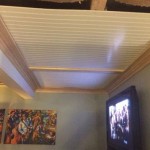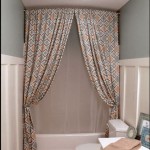Wood Ceiling Treatment Ideas: Enhancing Aesthetics and Functionality
Wood ceilings offer a timeless appeal, bringing warmth, character, and a touch of nature into any space. However, a bare wood ceiling may not always achieve the desired aesthetic or provide optimal performance. Various treatment options exist to enhance the visual impact, improve acoustic properties, and protect the wood from environmental factors. This article explores a range of wood ceiling treatment ideas, covering staining, painting, texturing, and other specialized finishes, providing a comprehensive guide for homeowners, designers, and builders seeking to elevate their interior spaces.
Choosing the right treatment for a wood ceiling involves considering several factors. The type of wood, the desired style, the room's purpose, and the existing architectural elements all play a role. A clear understanding of the available options and their associated benefits and drawbacks is crucial for achieving a successful and long-lasting result.
Staining for Natural Beauty
Staining is a popular choice for wood ceilings, as it enhances the natural grain and color of the wood while providing a protective layer. Unlike paint, stain does not completely obscure the wood's texture. Instead, it penetrates the surface, highlighting the unique patterns and characteristics of the material. Stains are available in a wide range of hues, from light and airy to dark and dramatic, allowing for customization to match any design scheme.
The staining process typically involves several steps. First, the wood surface must be properly prepared. This includes cleaning the ceiling to remove any dust, dirt, or existing finishes. Sanding may be necessary to create a smooth and even surface, allowing the stain to penetrate evenly. After sanding, the surface should be wiped clean to remove any sanding dust. A pre-stain wood conditioner is often recommended, particularly for softwoods, as it helps to prevent blotching and ensures a more uniform application of the stain.
The stain is then applied using a brush, rag, or sprayer. The excess stain should be wiped off after a few minutes, allowing the desired color to remain. Multiple coats may be applied to achieve a deeper or richer color. It's crucial to follow the manufacturer's instructions regarding drying times and application techniques. Once the stain is dry, a clear topcoat, such as varnish or polyurethane, can be applied to protect the stained surface and provide added durability.
Different types of stains are available, including oil-based, water-based, and gel stains. Oil-based stains tend to offer richer colors and better penetration, but they can be more difficult to work with and require longer drying times. Water-based stains are easier to clean up and have lower VOC (volatile organic compound) emissions, making them a more environmentally friendly option. Gel stains are thicker than liquid stains and are ideal for vertical surfaces or for achieving a uniform color on uneven wood grain.
Painting for Versatile Aesthetics
Painting a wood ceiling provides a versatile option for achieving a specific aesthetic. Unlike staining, paint completely covers the wood grain, offering a uniform color and texture. This can be particularly useful for covering up imperfections or for creating a more modern or minimalist look. Paint is available in an extensive range of colors and finishes, allowing for endless design possibilities.
Preparing the wood ceiling for paint is similar to preparing it for stain. The surface must be clean, smooth, and free of any existing finishes. Sanding is often necessary to create a suitable surface for the paint to adhere to. A primer is essential, as it helps to seal the wood, prevent bleed-through from tannins, and improve the adhesion of the paint. An oil-based primer is typically recommended for wood, as it provides better sealing and adhesion than water-based primers.
The paint can be applied using a brush, roller, or sprayer. Multiple coats are usually required to achieve full coverage and a uniform finish. It's important to allow each coat to dry completely before applying the next. Different types of paint are available, including latex, acrylic, and oil-based paints. Latex and acrylic paints are water-based and are easier to clean up and have lower VOC emissions. Oil-based paints offer better durability and a smoother finish, but they require more effort to clean up and have higher VOC emissions.
The choice of paint finish can also significantly impact the overall aesthetic. Matte finishes provide a soft, non-reflective look, while gloss finishes offer a high-shine, reflective appearance. Satin and eggshell finishes fall in between, offering a subtle sheen. Matte finishes are often preferred for ceilings, as they help to hide imperfections and reduce glare. Gloss finishes can be used to create a more dramatic or modern look, but they tend to highlight any imperfections in the surface.
Texturing and Specialized Finishes for Unique Design
Beyond staining and painting, a variety of texturing and specialized finishes can be used to create unique and visually striking wood ceilings. These options can add depth, character, and a touch of artistry to any space. Texturing techniques can range from simple brushing to more elaborate methods, such as applying a crackle finish or using a faux painting technique.
One popular texturing technique involves applying a wood graining tool to wet paint or stain. This creates a simulated wood grain pattern, which can be used to enhance the natural grain of the wood or to create a more rustic or antique look. Another option is to use a textured paint or primer to create a raised pattern on the ceiling. This can add depth and visual interest to the surface.
Specialized finishes, such as whitewashing, limewashing, and cerusing, can also be used to create unique and stylish wood ceilings. Whitewashing involves applying a diluted white paint to the wood, allowing the grain to show through. This creates a light and airy look that is often associated with coastal or farmhouse styles. Limewashing is similar to whitewashing, but it uses a lime-based paint, which creates a more textured and matte finish.
Cerusing, also known as grain filling, involves filling the wood grain with a contrasting color, such as white or gold. This highlights the grain and creates a striking visual effect. The process typically involves applying a colored filler to the wood, allowing it to dry, and then sanding the surface to remove the filler from the surface, leaving it only in the grain. This technique is often used on hardwoods, such as oak and ash, which have pronounced grain patterns.
In addition to these traditional techniques, modern finishes, such as metallic paints and epoxy coatings, can also be used to create dramatic and contemporary wood ceilings. Metallic paints can add a touch of glamour and sophistication, while epoxy coatings provide a durable and glossy finish that is resistant to scratches and stains. The choice of finish will depend on the desired aesthetic and the specific needs of the space.
Beyond aesthetics, treatments can also enhance the functionality of a wood ceiling. For example, applying a sound-absorbing finish can improve the acoustics of a room, reducing echo and reverberation. This is particularly important in spaces such as home theaters, offices, and restaurants. Fire-retardant coatings can also be applied to wood ceilings to improve their fire resistance, enhancing safety.
Ultimately, the best wood ceiling treatment will depend on a variety of factors, including the type of wood, the desired style, the room's purpose, and the budget. By carefully considering these factors and exploring the available options, it is possible to create a wood ceiling that is both beautiful and functional, enhancing the overall appeal and value of the space.

Wood Ceiling Ideas Ceilings Armstrong Residential

Diy Planked Wood Ceiling The Lilypad Cottage

Wood Ceiling Design Ideas 21 Designer Rooms With Ceilings
:max_bytes(150000):strip_icc()/328876915_3483068721912822_7533288323520714674_n-ec0a53669b42476da69f4892d8350798.jpg?strip=all)
20 Wood Ceiling Ideas We Love For Any Room

25 Eye Catchy Wooden Ceiling Ideas To Try Digsdigs

Wood Ceiling Ideas Ceilings Armstrong Residential

10 Accent Ceiling Ideas That Will Transform A Room Fhl Design Rockwall Interior

Wood Ceilings Board 21 Ideas From Ceiling

An Innovative Decorative Ceiling Treatment Makes A Grand Room

7 Ceiling Design Ideas That Keep It Interesting Thistlewood Farm
Related Posts








